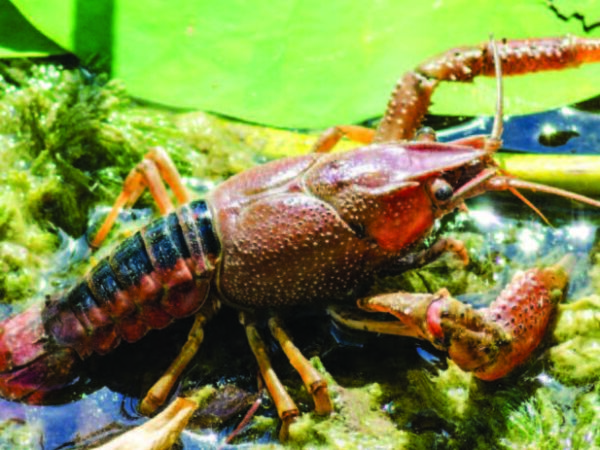
White River Crayfish
(Procambarus acutus)
Species at a Glance
The White River Crayfish, also known as the White River Crawfish or the Eastern White River Crayfish, is native to parts of the United States but has been introduced beyond its natural range. Although its environmental impacts have not been extensively studied, its rapid growth, high reproductive rates, and competitive nature make it a concern for native crayfish. Additionally, it may serve as a vector of spread of parasites and disease.
Species Description
Adult White River Crayfish are typically a dark burgundy red but can vary in color from pinkish tan to brownish-olive, often with a distinctive black, V-shaped stripe across the abdomen. The carapace has a rough, granular texture and is divided down the middle by a narrow space called the areola. Juveniles are generally gray with dark spots scattered over the carapace. The species is characterized by long, slender claws with a delicate appearance and small dark tubercles. The White River Crayfish typically grows to a length of 6-13 cm (2.5-5 in).
Native & Introduced Ranges
The native range of the White River Crayfish extends from the Southern Atlantic Coast drainage from Georgia to Maine, from the Florida panhandle to Mexico, and from the Central Mississippi Valley to the Upper Great Lakes drainages. It was intentionally introduced into California and New England for aquaculture and bait and has been found in multiple counties throughout Pennsylvania.
Biology & Spread
Widely used in bait and aquaculture, the White River Crayfish most likely spread beyond its native range through human activities, such as release by anglers, aquarists keeping them as pets, landowners stocking in private ponds, and by consumers purchasing them from live food markets.
Habitat
The White River Crayfish is typically found in open waters of sloughs, swampy areas, sluggish lowland streams and ditches, or in floodplains. It will frequently burrow into sediments to escape drying or freezing.
Impacts
Threat to Biodiversity
Although the environmental impacts of this species have not been well documented, the White River Crayfish may pose a threat to aquatic ecosystems due to its rapid growth rate, high fecundity, aggressive behavior, and feeding habits. Because it is an opportunistic feeder, it is expected to outcompete native crayfish for resources like shelter and food. It may also impact biodiversity by hybridizing with other crayfish of the same genus.
Health
The White River Crayfish may be a vector of spread for parasites and diseases such as the crayfish plague, that can pose a threat to commercial species.
Prevention & Control
The best way to prevent further ecological problems caused by the White River Crayfish is to prevent or slow its spread into new waters. Never release live bait into any water body and never transport any crayfish from one water body to another. In Pennsylvania it is illegal to possess, import, or transport any crayfish species unless they are used as bait in the water they were taken from, or unless the head is immediately removed above the eyes before transport.
References:
- Lieb, D.A., Bouchard, R.W., Carline, R.F., Nuttall, T.R., Wallace, J.R. and Burkholder, C.L. 2011.
- Conservation and management of crayfishes: lessons learned from Pennsylvania. Fisheries 36
- (10):489-507
- U.S. Fish and Wildlife Service. 2015. White River Crayfish (Procambarus acutus) Ecological Risk Screening Summary.



